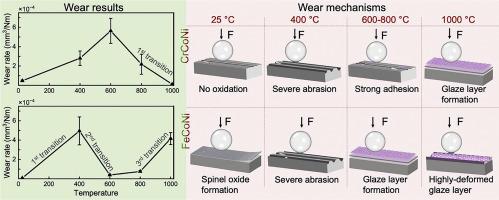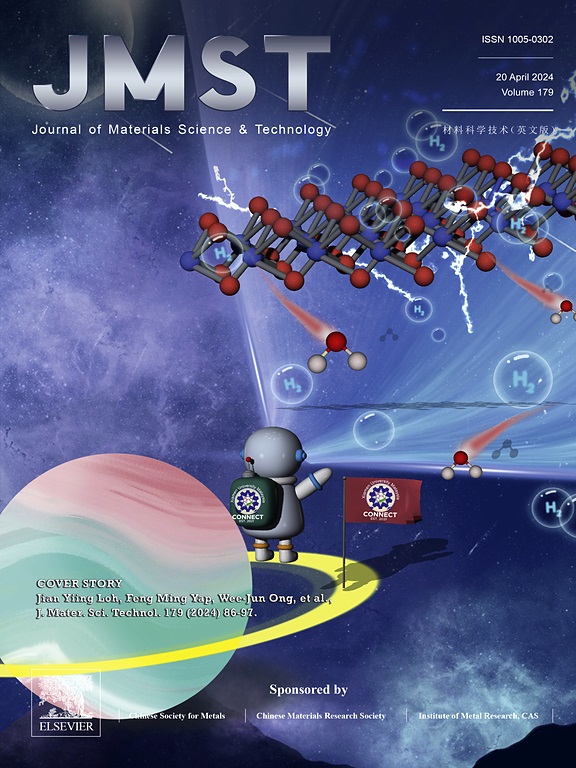Wear mechanism transitions in FeCoNi and CrCoNi medium-entropy alloys from room temperature to 1,000°C
IF 14.3
1区 材料科学
Q1 MATERIALS SCIENCE, MULTIDISCIPLINARY
引用次数: 0
Abstract
Many machine components are operated in dry sliding, elevated temperature, and oxidizing environments, leading to material failure or loss of functionality. Despite previous wear studies on conventional alloys, wear-related properties in high-entropy alloys (HEAs) and medium-entropy alloys (MEAs) up to 1,000°C are rarely reported. Here we systematically study the high-temperature hardness, wear behaviours and mechanisms of two popular MEAs, FeCoNi and CrCoNi, from room temperature to 1,000°C. We find that the wear resistance of FeCoNi surpasses that of CrCoNi at room temperature, 600°C, and 800°C. Contrarily, the wear resistance of CrCoNi surpasses that of FeCoNi at 400°C and 1,000°C. By characterizing wear tracks, we identify that these wear-mechanism transitions are associated with alloy elements, oxidation rates, and oxide types. At room temperature, FeCoNi forms a spinel oxide layer with a lower wear rate than CrCoNi. At 400°C, the wear rates of FeCoNi and CrCoNi are comparable because of temperature softening. At 600°C and 800°C, FeCoNi shows Co3O4 as the main constituent of the glaze layer, enhancing wear resistance compared to CrCoNi. At 1,000°C, such glaze layer in FeCoNi undergoes severe plastic deformation, reducing its wear resistance; the Cr2O3 oxide layer formed in CrCoNi remains hard and less deformable, contributing to its higher wear resistance. This study provides a fundamental understanding of the effect of principal elements on the wear performance in FeCoNi and CrCoNi-related MEAs and HEAs.

FeCoNi和CrCoNi中熵合金从室温到1000℃的磨损机制转变
许多机器部件在干燥滑动、高温和氧化环境中运行,导致材料失效或功能丧失。尽管以前对传统合金进行了磨损研究,但高熵合金(HEAs)和中熵合金(MEAs)高达1000°C的磨损相关性能很少被报道。本文系统地研究了两种常用的MEAs (FeCoNi和CrCoNi)在室温至1000℃范围内的高温硬度、磨损行为和机理。我们发现FeCoNi在室温、600℃和800℃下的耐磨性优于CrCoNi。在400℃和1000℃时,CrCoNi的耐磨性优于FeCoNi。通过表征磨损轨迹,我们发现这些磨损机制的转变与合金元素、氧化速率和氧化物类型有关。常温下,FeCoNi形成尖晶石氧化层,其磨损率低于CrCoNi。在400℃时,由于温度软化,FeCoNi和CrCoNi的磨损率相当。在600°C和800°C时,FeCoNi的釉层主要成分为Co3O4,与CrCoNi相比,其耐磨性增强。在1000℃时,FeCoNi中的这种釉层发生剧烈的塑性变形,其耐磨性降低;在CrCoNi中形成的Cr2O3氧化层保持坚硬且不易变形,从而提高了CrCoNi的耐磨性。本研究为了解主要元素对FeCoNi和crconi相关mea和HEAs磨损性能的影响提供了基本的认识。
本文章由计算机程序翻译,如有差异,请以英文原文为准。
求助全文
约1分钟内获得全文
求助全文
来源期刊

Journal of Materials Science & Technology
工程技术-材料科学:综合
CiteScore
20.00
自引率
11.00%
发文量
995
审稿时长
13 days
期刊介绍:
Journal of Materials Science & Technology strives to promote global collaboration in the field of materials science and technology. It primarily publishes original research papers, invited review articles, letters, research notes, and summaries of scientific achievements. The journal covers a wide range of materials science and technology topics, including metallic materials, inorganic nonmetallic materials, and composite materials.
 求助内容:
求助内容: 应助结果提醒方式:
应助结果提醒方式:


